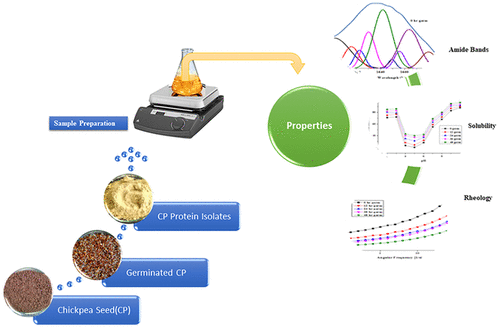当前位置:
X-MOL 学术
›
ACS Food Sci. Technol.
›
论文详情
Our official English website, www.x-mol.net, welcomes your
feedback! (Note: you will need to create a separate account there.)
Effect of Germination Time on Physicochemical, Electrophoretic, Rheological, and Functional Performance of Chickpea Protein Isolates
ACS Food Science & Technology ( IF 2.6 ) Pub Date : 2021-05-06 , DOI: 10.1021/acsfoodscitech.0c00067 Sajad Ahmad Sofi 1, 2 , Jagmohan Singh 1 , Khalid Muzaffar 2 , B. N. Dar 2
ACS Food Science & Technology ( IF 2.6 ) Pub Date : 2021-05-06 , DOI: 10.1021/acsfoodscitech.0c00067 Sajad Ahmad Sofi 1, 2 , Jagmohan Singh 1 , Khalid Muzaffar 2 , B. N. Dar 2
Affiliation

|
This study was carried out to investigate the physicochemical, functional, electrophoretic, structural, thermal, and rheological properties of protein isolates obtained from germinated chickpeas at different germination times (0, 12, 36, and 48 h). An increase in germination time changed lightness (58.57 to 61.44), whiteness index (1.25 to 15.29), protein isolate recovery (19.84 to 21.34%), protein content (85.08 to 87.78%), antioxidant activity (25.83 to 31.58%), in vitro protein digestibility (86.35 to 93.76%), and degree of hydrolysis (0 to 1.89%) of protein isolates extracted from chickpea seeds. Significant increases (p < 0.05) in water absorption capacity (3.08 to 4.82 g/g), oil absorption capacity (4.45 to 5.58 g/g), emulsifying capacity (43.47 to 45.61 m2/g), foaming capacity (58.74 to 69.48%), and foaming stability (60.37 to 64.86%) were observed for the protein isolates with an increase in germination time (0 to 48 h). Storage and loss modulus decreased with an increase in germination time (0 to 48 h) of protein isolates that behave like weak gel materials (G′ > G″). Power law, Herschel–Bulkley, Bingham, and Casson models showed the best fit to rheological data, with R2 being greater than 0.93. Protein isolates showed a significant decrease in onset temperature (91.86 to 80.45 °C), peak temperature (107.20 to 95.41 °C), and enthalpy (3.65 to 2.48 J/g) with an increase in germination time. The electrophoretic study showed a slight variation in band intensities corresponding to proteins with low and high molecular weight. An increase in the secondary structure of amide I showed a reduction of α-helices (21.52 to 19.87%) and β-sheets (57.45 to 53.52%) and an increase in β-turns (18.17 to 19.64%) and random coils (3.30 to 6.97%) in chickpea protein isolates after 48 h of germination.
中文翻译:

发芽时间对鹰嘴豆分离蛋白理化、电泳、流变和功能性能的影响
本研究旨在研究从不同发芽时间(0、12、36 和 48 小时)发芽的鹰嘴豆获得的蛋白质分离物的物理化学、功能、电泳、结构、热和流变学特性。发芽时间的增加改变了亮度(58.57 到 61.44)、白度指数(1.25 到 15.29)、分离蛋白回收率(19.84 到 21.34%)、蛋白质含量(85.08 到 87.78%)、抗氧化活性(25.83 到 31.58%)、从鹰嘴豆种子中提取的蛋白质分离物的体外蛋白质消化率(86.35 至 93.76%)和水解度(0 至 1.89%)。吸水能力(3.08 至 4.82 g/g)、吸油能力(4.45 至 5.58 g/g)、乳化能力(43.47 至 45.61 m 2)显着增加(p < 0.05)/g)、发泡能力(58.74 至 69.48%)和发泡稳定性(60.37 至 64.86%)随着发芽时间的增加(0 至 48 小时)被观察到。储存和损耗模量随着发芽时间(0 到 48 小时)的增加而降低,蛋白质分离物的行为类似于弱凝胶材料(G '> G '' )。幂律、Herschel-Bulkley、Bingham 和 Casson 模型显示最适合流变数据,R 2大于 0.93。随着发芽时间的增加,蛋白质分离物的起始温度(91.86 至 80.45 °C)、峰值温度(107.20 至 95.41 °C)和焓(3.65 至 2.48 J/g)显着降低。电泳研究表明,与低分子量和高分子量蛋白质相对应的条带强度略有变化。酰胺 I 二级结构的增加表明 α-螺旋(21.52 至 19.87%)和 β-折叠(57.45 至 53.52%)和β-转角(18.17 至 19.64%)和无规卷曲(3.30)的增加发芽 48 小时后,鹰嘴豆分离蛋白中的含量增加到 6.97%。
更新日期:2021-06-18
中文翻译:

发芽时间对鹰嘴豆分离蛋白理化、电泳、流变和功能性能的影响
本研究旨在研究从不同发芽时间(0、12、36 和 48 小时)发芽的鹰嘴豆获得的蛋白质分离物的物理化学、功能、电泳、结构、热和流变学特性。发芽时间的增加改变了亮度(58.57 到 61.44)、白度指数(1.25 到 15.29)、分离蛋白回收率(19.84 到 21.34%)、蛋白质含量(85.08 到 87.78%)、抗氧化活性(25.83 到 31.58%)、从鹰嘴豆种子中提取的蛋白质分离物的体外蛋白质消化率(86.35 至 93.76%)和水解度(0 至 1.89%)。吸水能力(3.08 至 4.82 g/g)、吸油能力(4.45 至 5.58 g/g)、乳化能力(43.47 至 45.61 m 2)显着增加(p < 0.05)/g)、发泡能力(58.74 至 69.48%)和发泡稳定性(60.37 至 64.86%)随着发芽时间的增加(0 至 48 小时)被观察到。储存和损耗模量随着发芽时间(0 到 48 小时)的增加而降低,蛋白质分离物的行为类似于弱凝胶材料(G '> G '' )。幂律、Herschel-Bulkley、Bingham 和 Casson 模型显示最适合流变数据,R 2大于 0.93。随着发芽时间的增加,蛋白质分离物的起始温度(91.86 至 80.45 °C)、峰值温度(107.20 至 95.41 °C)和焓(3.65 至 2.48 J/g)显着降低。电泳研究表明,与低分子量和高分子量蛋白质相对应的条带强度略有变化。酰胺 I 二级结构的增加表明 α-螺旋(21.52 至 19.87%)和 β-折叠(57.45 至 53.52%)和β-转角(18.17 至 19.64%)和无规卷曲(3.30)的增加发芽 48 小时后,鹰嘴豆分离蛋白中的含量增加到 6.97%。











































 京公网安备 11010802027423号
京公网安备 11010802027423号